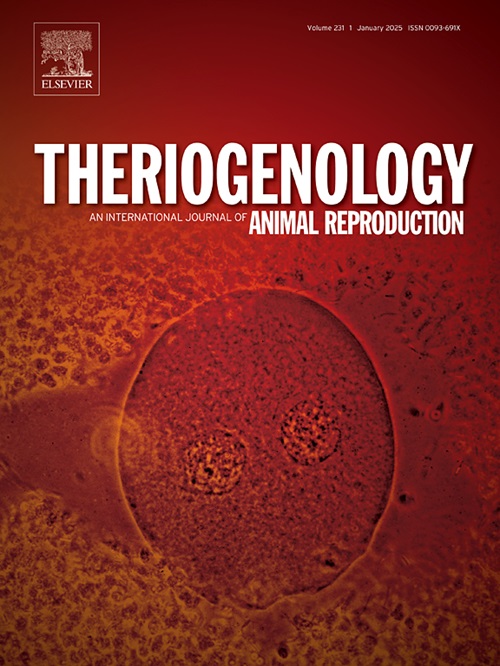睾丸高表达Lrwd1的种系特异性缺失揭示了在男性生育能力中非必要的作用
IF 2.4
2区 农林科学
Q3 REPRODUCTIVE BIOLOGY
引用次数: 0
摘要
遗传病因是男性因素性不育症的主要原因,这是一个影响7%以上育龄男性人口的全球健康问题。综合转录组分析已经确定了2300多个小鼠睾丸优势基因,敲除模型在功能上验证了许多位点在保持生育能力方面的关键作用。然而,大部分男性生殖细胞基因的生物学意义仍不清楚。本研究旨在探讨富亮氨酸重复序列和WD40重复结构域蛋白1 (Lrwd1)在雄性生殖中的功能。在这里,我们使用CRISPR/Cas9技术产生了带有Stra8-Cre (Lrwd1- sko)的生殖细胞特异性Lrwd1敲除小鼠,并评估了它们的生育能力。我们的研究结果表明,Lrwd1的缺失不影响雄性小鼠的生育能力,Lrwd1- sko与对照小鼠在精子形态上没有显著差异。睾丸和附睾组织的组织学分析显示,精管包含生殖细胞发育的所有阶段,包括成熟精子,没有明显的改变。此外,生殖细胞中Lrwd1的消融未影响精母细胞通过I前期的进展。这些发现表明Lrwd1在小鼠精子发生或雄性生育中不是必需的,这表明它在正常生理条件下对生殖功能没有关键作用。本文章由计算机程序翻译,如有差异,请以英文原文为准。
Germline-specific deletion of testis-highly expressed Lrwd1 reveals nonessential roles in male fertility
Genetic etiologies constitute a major contributor to male factor infertility, a global health concern impacting over 7% of the reproductive-aged male population. Comprehensive transcriptomic profiling has identified more than 2300 mouse testicular-predominant genes, with knockout models functionally validating the critical role of numerous loci in preserving fertility. However, the biological significance of large portions of the male germ cell genes remains unclear. The present study aimed to investigate the function of leucine-rich repeats and WD40 repeat domain-containing protein 1 (Lrwd1) in male reproduction. Here we generated germ cell-specific Lrwd1 knockout mice with Stra8-Cre (Lrwd1-sKO) using CRISPR/Cas9 technology and assessed their fertility. Our results demonstrated that the absence of Lrwd1 did not affect the fertility of male mice, and no significant differences in sperm morphology were observed between Lrwd1-sKO and control mice. Histological analysis of testicular and epididymal tissues revealed that seminiferous tubules contained all stages of germ cell development, including mature spermatozoa, without noticeable alterations. Additionally, the progression of spermatocytes through prophase I was not impaired in ablation of Lrwd1 in germ cell. These findings suggest that Lrwd1 is not essential for spermatogenesis or male fertility in mice, indicating that it does not play a critical role in reproductive function under normal physiological conditions.
求助全文
通过发布文献求助,成功后即可免费获取论文全文。
去求助
来源期刊

Theriogenology
农林科学-生殖生物学
CiteScore
5.50
自引率
14.30%
发文量
387
审稿时长
72 days
期刊介绍:
Theriogenology provides an international forum for researchers, clinicians, and industry professionals in animal reproductive biology. This acclaimed journal publishes articles on a wide range of topics in reproductive and developmental biology, of domestic mammal, avian, and aquatic species as well as wild species which are the object of veterinary care in research or conservation programs.
 求助内容:
求助内容: 应助结果提醒方式:
应助结果提醒方式:


